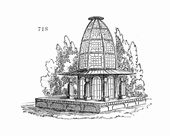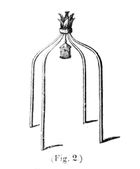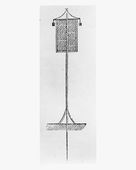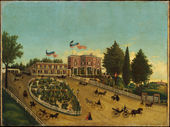Difference between revisions of "Aviary/Bird cage/Birdhouse"
| Line 10: | Line 10: | ||
[[File:1787.jpg|thumb|right|150px|Fig. 3, Anonymous, "An accidental wren box" in an ornamental iron post, in [[A. J. Downing]], ed. ''Horticulturist'' 4, no. 4 (October 1849): p. 168]] | [[File:1787.jpg|thumb|right|150px|Fig. 3, Anonymous, "An accidental wren box" in an ornamental iron post, in [[A. J. Downing]], ed. ''Horticulturist'' 4, no. 4 (October 1849): p. 168]] | ||
| + | |||
| + | [[File:0734.jpg|thumb|right, Fig. 4, |[[William Russell Birch]], ''Front of the Aviary/Grove, Springland'', before 1805.]] | ||
Treatises recommended that the style of an aviary or birdhouse be determined by its setting, particularly the architectural style of the principal dwelling. For example, [[A. J. Downing]] recommended Gothic detailing in outbuildings and garden structures, such as aviaries, to complement the architecture of the main house. This advice followed the general principles used for the design of other animal, bird, and insect-keeping structures found in American designed landscapes. Barns, poultry houses, and chicken coops were important parts of farm and plantation economies, and occasionally were ornamented to reflect the particular program of the landscape design. [[J. C. Loudon]]’s (1826) detailed description of aviary types indicates the possible range of forms: a floating aviary for waterfowl, a glassed canary aviary, and portable aviaries made of net and wire [Fig. 5]. One illustration from the ''New England Farmer'' in 1841 depicts a bird cage suspended from four slender columns [Fig. 6]. Although Loudon described the British practice of furnishing aviaries with dead or living trees for the birds’ perch, no evidence exists for such American examples. | Treatises recommended that the style of an aviary or birdhouse be determined by its setting, particularly the architectural style of the principal dwelling. For example, [[A. J. Downing]] recommended Gothic detailing in outbuildings and garden structures, such as aviaries, to complement the architecture of the main house. This advice followed the general principles used for the design of other animal, bird, and insect-keeping structures found in American designed landscapes. Barns, poultry houses, and chicken coops were important parts of farm and plantation economies, and occasionally were ornamented to reflect the particular program of the landscape design. [[J. C. Loudon]]’s (1826) detailed description of aviary types indicates the possible range of forms: a floating aviary for waterfowl, a glassed canary aviary, and portable aviaries made of net and wire [Fig. 5]. One illustration from the ''New England Farmer'' in 1841 depicts a bird cage suspended from four slender columns [Fig. 6]. Although Loudon described the British practice of furnishing aviaries with dead or living trees for the birds’ perch, no evidence exists for such American examples. | ||
Revision as of 15:39, November 30, 2016
See also: Dovecoat
History

An aviary was a structure, enclosure, or cage for keeping birds. While henhouses and other more utilitarian structures for keeping fowl were relatively common in America, aviaries were generally reserved for ornamental and exotic birds, as well as songbirds. A wide variety of aviary types were discussed in treatises, particularly in publications from the second half of the nineteenth century, but the relative scarcity of American examples suggests that they were fragile structures, seldom recorded in the seventeenth century and rare through the eighteenth and first half of the nineteenth century. More common in America, however, was the practice of keeping doves and pigeons (see Dovecote).
Birdhouses, such as the one at Spring-land, William Russell Birch’s estate, near Bristol, Pa. [Fig. 1], the one depicted in a notarial record [Fig. 2], and the “accidental wren box” at Laurel Hill Cemetery in Philadelphia [Fig. 3], allowed birds to come and go freely. Aviaries and bird cages, by contrast, kept birds confined. Aviaries could be located indoors or outdoors. They were often situated in conservatories or greenhouses, where the warmth suited plant and bird alike; an example of this is found at Monticello. An aviary built free-standing in the garden is found in Birch’s design for the Elysian Bower at Springland [Fig. 4].

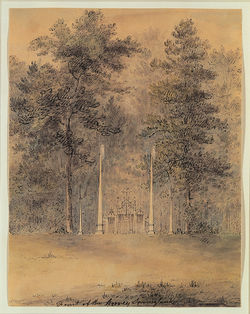
Treatises recommended that the style of an aviary or birdhouse be determined by its setting, particularly the architectural style of the principal dwelling. For example, A. J. Downing recommended Gothic detailing in outbuildings and garden structures, such as aviaries, to complement the architecture of the main house. This advice followed the general principles used for the design of other animal, bird, and insect-keeping structures found in American designed landscapes. Barns, poultry houses, and chicken coops were important parts of farm and plantation economies, and occasionally were ornamented to reflect the particular program of the landscape design. J. C. Loudon’s (1826) detailed description of aviary types indicates the possible range of forms: a floating aviary for waterfowl, a glassed canary aviary, and portable aviaries made of net and wire [Fig. 5]. One illustration from the New England Farmer in 1841 depicts a bird cage suspended from four slender columns [Fig. 6]. Although Loudon described the British practice of furnishing aviaries with dead or living trees for the birds’ perch, no evidence exists for such American examples.
Aviaries were valued in garden design, as George William Johnson noted in 1847, because of the birds’ singing and plumage. They also provided objects of interest in the garden and could be used as a focal point at the termination or crossing of a walk, as Batty Langley advised in 1728. Like specialized structures for exotic plants, aviaries provided a place to display one’s interest in and knowledge of the natural world. Both the access to exotic species and the means to keep them was once the province of only the wealthiest of Europe, and this association continued to lend status to the keeping of rare and ornamental birds. A singing bird not only graced a garden with its song, but also signified the owner’s erudition and connection with the world of foreign trade and exotic lands, as did swans on a lake or peacocks strolling on a lawn.
-- Elizabeth Kryder-Reid
Texts
Usage
- Anonymous, July 1, 1771, describing a property for sale in the vicinity of Charleston, S.C. (South Carolina and American General Gazette)
- "There are on the Premises . . . two well contrived AVIARIES, and every BUILDING necessary on a Farm."
- Weld, Isaac, 1795, describing Monticello, plantation of Thomas Jefferson, Charlottesville, Va. (1799: 119) [1]
- "A large apartment is laid out for a library and museum, meant to extend the entire breadth of the house, the windows of which are to open into an extensive greenhouse and aviary."
- Committee of the Pennsylvania Horticultural Society, 1830, describing the McAran Botanic Garden and Nursery, Philadelphia, Pa. (quoted in Boyd 1929: 434) [2]
- "A small Aviary and Apiary are attached."
- Anonymous, December 6, 1835, "Leaves from My Note Book" (Horticultural Register 2: 31) [3]
- "I called, the next day after my arrival, at your friend Thorburn's Horticultural Repository, 11, John Street. . . . The second floor offers a fine lounge for one who wishes to pass an hour listening to 'fairy-like music,' and feasting his eyes on beautiful paintings and engravings which hang on the surrounding walls. The aviary, at one end, is filled with many beautiful birds which fill the air with their songs—the native mocking bird, canary, &c. &c. all exerting their sweet voices in a mingled harmony, and fluttering as merrily as in their native woods."
Citations
- Langley, Batty, 1728, New Principles of Gardening (1982: 195–99) [4]
- "General DIRECTIONS, &c....
- "XXI. Such Walks as must terminate within the Garden, are best finish'd with Mounts, Aviaries, Grotto's, Cascades, Rocks, Ruins, Niches, or Amphitheatres of Ever-Greens, variously mix'd, with circular Hedges ascending behind one another, which renders a very graceful Appearance."
- Loudon, J. C., 1826, An Encyclopaedia of Gardening (pp. 339, 347, 1020, 1183) [5]
- "1722. Collecting and preserving ice, rearing bees, &c. however, unsuitable or discordant it may appear, it has long been the custom to delegate to the care of the gardener. In some cases also he has the care of the dove-house, fish-ponds, aviary, a menagerie of wild beasts, and places for snails, frogs, dormice, rabbits, &c. but we shall only consider the ice-house, apiary, and aviary, as legitimately belonging to gardening, leaving the others to the care of the gamekeeper, or to constitute a particular department in domestic or rural economy. . . .
- "1761. The canary or singing-bird aviary used not unfrequently to be formed in the opaque-roofed green-house or conservatory, by enclosing one or both ends with a partition of wire; and furnishing them with dead or living trees, or spray and branches suspended from the roof for the birds to perch on. Such are chiefly used for the canary, bullfinch, linnet, &c.
- "1762. The parrot aviary is generally a building formed on purpose, with a glass roof, front, and ends; with shades and curtains to protect it from the sun and frost, and a flue for winter heating. In these, artificial or dead trees with glazed foliage are fixed in the floor, and sometimes cages hung on them; and at other times the birds allowed to fly loose. . . .
- "1763. The verdant aviary is that in which, in addition to houses for the different sorts of birds, a net or wire curtain is thrown over the tops of trees, and supported by light posts or hollow rods, so as to enclose a few poles, or even acres of ground, and water in various forms. In this the birds in fine weather sing on the trees, the aquatic birds sail on the water, or the gold-pheasants stroll over the lawn, and in severe seasons they betake themselves to their respective houses or cages. Such an enclosed space will of course contain evergreen, as well as deciduous trees, rocks, reeds, aquatics, long grass for larks and partridges, spruce firs for pheasants, furze-bushes for linnets, &c. . . .
- "1764. Gallinaceous aviary. At Chiswick, portable netted enclosures, from ten to twenty feet square, are distributed over a part of the lawn, and display a curious collection of domestic fowls. In each enclosure is a small wooden box or house for sheltering the animals during the night, or in severe weather, and for breeding. Each cage or enclosure is contrived to contain one or more trees or shrubs; and water and food are supplied in small basins and appropriate vessels. Curious varieties of aquatic fowls might be placed on floating aviaries on a lake or pond. . . .
- "7258. Narrow terraces....In some cases, the terrace-walls may be so extended as to enclose ground sufficient for a level plot to be used as a bowling-green or a flower-garden. These are generally connected with one of the living-rooms or the conservatory, and to the latter is frequently joined an aviary and the entire range of botanic stoves. Or, the aviary may be made an elegant detached building, so placed as to group with the house and other surrounding objects. An elegant structure of this sort . . . was designed by Repton for the grounds of the Pavilion at Brighton." [Fig. 7]
- Webster, Noah, 1828, An American Dictionary of the English Language (1:n.p.) [6]
- "A'VIARY, n. [ L. aviarium, from avis, a fowl.]
- "A bird cage; an inclosure for keeping birds confined. Wotton."
- Loudon, J. C., 1834, An Encyclopaedia of Gardening (p. 1183) [7]
- "6781. Animated nature. Deer, wild and tame hares, cattle, sheep, game, singing birds, all belong to a residence, and are necessary to complete its beauty. Pheasants and other game, ranging undismayed by man, in garden-scenes, give a high idea of seclusion and removal from common nature; the finer sorts may be retained in appropriate structures. . . and the common left to themselves, but liberally supplied with food. The cawing of rooks, the shrieking of the owl, the screams of peacocks, the notes of birds, are all desirable circumstances in certain situations, and ought to be attended to, by introducing such trees or plants as are favourable to their increase." [Fig. 8]
- Loudon, J. C., 1838, The Suburban Gardener (p. 711) [8]
- "The Aviary is an enclosure which should always, if possible, be of considerable extent, containing houses for different kinds of birds. These houses may be small rustic structures, each with an enclosed court, and covered with netting or wirework, to prevent the birds from flying away, as well as to prevent the intrusion of other birds in a wild state."
- Johnson, George William, 1847, A Dictionary of Modern Gardening (p. 74) [9]
- "AVIARY. This building, devoted to the rearing of birds distinguished for the beauty either of their notes or plumage, is rarely admitted within a garden, and still more rarely are they sufficiently ornamental or sufficiently free from disagreeables to be a source of pleasure. . . ."
Images
Inscribed
William Russell Birch, Front of the Aviary/Grove, Springland, before 1805.
J. C. Loudon, Aviary designed by Humphry Repton for the grounds of the Pavilion at Brighton, in An Encyclopædia of Gardening (1826), p. 1020, fig. 718.
J. C. Loudon, Plan of farmyard, garden offices and hot-houses at Cheshunt Cottage, in The Gardener's Magazine 15, no. 117 (December 1839): p. 642, fig. 159. "4 d, An aviary for canaries"
Attributed
William Russell Birch, Design for a Gothic Birdhouse at Springland, before 1805.
J. C. Loudon, "Wire-cages," in An Encyclopædia of Gardening (1826), p. 347, fig. 301.
J. C. Loudon, One of the "Accidental Accompaniments to the Materials of Landscape," for birds and animals, in An Encyclopaedia of Gardening (1834), p. 1183, fig. 947.
Anonymous, "An accidental wren box" in an ornamental iron post, in A. J. Downing, ed. Horticulturist 4, no. 4 (October 1849): p. 168, fig. 79.
Notes
- ↑ Isaac Weld, Travels through the States of North America and the Provinces of Upper and Lower Canada, during the Years 1795, 1796, and 1797 (London: John Stockdale, 1799), view on Zotero.
- ↑ James Boyd, A History of the Pennsylvania Horticultural Society, 1827-1927 (Philadelphia: Pennsylvania Horticultural Society, 1929), view on Zotero.
- ↑ Anonymous, "Leaves from My Note Book," The Horticultural Register and Gardener’s Magazine 2 (January 1, 1836): 29–33, view on Zotero.
- ↑ Batty Langley, New Principles of Gardening, or The Laying out and Planting Parterres, Groves, Wildernesses, Labyrinths, Avenues, Parks, &c. (Originally published London: A. Bettesworth and J. Batley, etc., 1982), view on Zotero.
- ↑ J. C. (John Claudius) Loudon, An Encyclopaedia of Gardening; Comprising the Theory and Practice of Horticulture, Floriculture, Arboriculture, and Landscape-Gardening, 4th edn. (London: Longman et al, 1826), view on Zotero.
- ↑ Noah Webster, An American Dictionary of the English Language, 2 vols. (New York: S. Converse, 1828), vol. 1, view on Zotero.
- ↑ J. C. (John Claudius) Loudon, An Encyclopaedia of Gardening; Comprising the Theory and Practice of Horticulture, Floriculture, Arboriculture, and Landscape-Gardening, New ed., considerably improved and enlarged (London: Longman et al, 1834), view on Zotero.
- ↑ J. C. (John Claudius) Loudon, The Suburban Gardener, and Villa Companion (London: Longman et al, 1838) view on Zotero.
- ↑ George William Johnson, A Dictionary of Modern Gardening, ed. by David Landreth (Philadelphia: Lea and Blanchard, 1847), view on Zotero.

